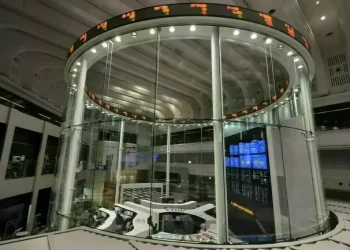Global stocks have advanced Friday after U.S. stocks rallied Thursday in Wall Street’s latest sharp swerve after a better-than-expected report on unemployment eased worries about the slowing economy.
European stocks opened higher and were set to recoup almost all the losses incurred during this week’s global market downturn. France’s CAC 40 rose 0.7% to 7,296.61. Germany’s DAX added 0.3% to 17,739.37 after a report said inflation in July rose 2.3% year-on-year, driven by the pressure on prices for services. Britain’s FTSE 100 rose 0.6% to 8,193.34.
The future for the S&P 500 was up 0.4% and the Dow Jones Industrial Average edged 0.2% higher.
In Tokyo, the Nikkei 225 index closed 0.6% higher at 35,025.00. The yen erased earlier losses in morning trading and extended its fourth consecutive day of gains against the dollar, with Japanese equities then losing momentum as it often falls when the yen rises.
Earlier this week, weaker-than-expected employment data from the U.S. raised concerns about a slowing economy where the Federal Reserve has kept the high interest rates that aim to stifle inflation for too long. That triggered a sell-off in global markets, with the scale of the declines amplified as investors unwound their yen carry trade positions.
On Friday trading, the U.S. dollar fell to 147.20 Japanese yen from 147.28 yen. The euro cost $1.0922, up from $1.0918.
China’s inflation came in higher than expected in July, with the consumer price index rising 0.5% compared to the same period a year earlier, boosted by food prices which are no longer dragging on inflation and were flat last month.
The Hang Seng in Hong Kong added 1.2% to 17,090.23, while the Shanghai Composite index edged down 0.3% to 2,862.19.
“The global market’s rebound was turbocharged by promising developments from the economic titans of the U.S. and China, suggesting that their economic engines are humming with a bit more vigor than many had anticipated,” Stephen Innes of SPI Asset Management said in a commentary.
In South Korea, the Kospi jumped 1.2% and ended at 2,588.43, Australia’s S&P/ASX 200 advanced 1.3% to 7,777.70.
Elsewhere, Taiwan’s Taiex picked up 2.9%, with chip maker Taiwan Semiconductor Manufacturing Co. gaining 4.2%, tracking Big Tech stocks’ rally on Wall Street. The SET in Bangkok was up 0.2%.
On Thursday, the S&P 500 jumped 2.3% to 5,319.31, for its best day since 2022 and shaved off all but 0.5% of its loss from what was a brutal start to the week. The Dow Jones Industrial Average rose 1.8% to 39,446.49, and the Nasdaq composite climbed 2.9% to 16,660.02 as Nvidia and other Big Tech stocks helped lead the way.
Treasury yields also climbed, signaling that investors are feeling calmer about the economy after a report showed fewer U.S. workers applied for unemployment benefits last week. The number was better than economists expected.
So far, the S&P 500 is still down nearly 10% from its all-time high set last month. Such drops are regular occurrences on Wall Street, and “corrections” of 10% happen roughly every year or two. After Thursday’s jump, the index is within about 6% of its record.
Still, the market’s swings look more like a “positioning-driven crash” caused by too many investors piling into similar trades and then exiting them together, rather than the start of a long-term downward market caused by a recession, according to strategists at BNP Paribas.
They say it looks more similar to the “flash crash” of 2010 than the 2008 global financial crisis or the 2020 recession caused by the pandemic.
In the bond market, the yield on the 10-year Treasury rose to 3.99% from 3.95% late Wednesday.
In energy trading, benchmark U.S. crude lost 2 cents to $76.17 a barrel. Brent crude, the international standard, gave up 7 cents to $79.09 a barrel.








